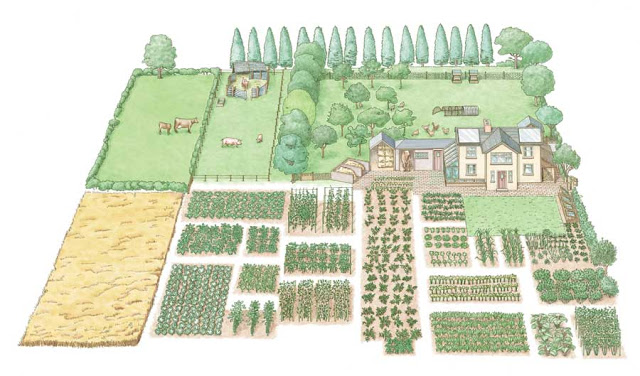Expert advice on how to establish self-sufficient food production, including guidance on crop rotations, raising livestock and grazing management.
John Seymour
Mother Earth News
Everyone will have a different approach to keeping a self-sufficient homestead, and it’s unlikely that any two 1-acre farms will follow the same plan or methods or agree completely on how to homestead. Some people like cows; other people are afraid of them. Some people like goats; other people cannot keep them out of the garden. Some people will not slaughter animals and have to sell their surplus stock off to people who will kill them; others will not sell surplus stock off at all because they know that the animals will be killed; and still others will slaughter their own animals to provide their family with healthy meat.
For myself, on a 1-acre farm of good, well-drained land, I would keep a cow and a goat, a few pigs and maybe a dozen hens. The goat would provide me with milk when the cow was dry. I might keep two or more goats, in fact. I would have the dairy cow (a Jersey) to provide the pigs and me with milk. More importantly, I would keep her to provide heaps and heaps of lovely cow manure to increase my soil fertility, for in order to derive any sort of living from that 1 acre without the application of a lot of artificial fertilizer, it would have to be heavily manured.
Cow or no cow? The pros and cons are many and various for a self-sufficient homestead. In favor of raising a cow is the fact that nothing keeps the health of a family — and a farm — at a high level better than a dairy cow. If you and your children have ample good, fresh, unpasteurized, unadulterated dairy products, you will be well-positioned to be a healthy family. If your pigs and poultry get their share of the milk by-products, especially whey, they likely will be healthy, too. If your garden gets plenty of cow manure, your soil fertility will continuously increase, along with your yields.
On the other hand, the food that you buy in for this family cow will cost you hundreds of dollars each year. Compared with how much money you would spend on dairy products each year, the fresh milk supply from the cow plus the increased value of the eggs, poultry and pig meat that you will get, along with your ever-growing soil fertility, will quickly make a family cow a worthwhile investment. But a serious counter-consideration is that you will have to take on the responsibility of milking a cow. (For different milking plans and estimated savings, see Keep a Family Cow and Enjoy Delicious Milk, Cream, Cheese and More.) Milking a cow doesn’t take very long — perhaps eight minutes — and it’s very pleasant if you know how to do it and if she is a quiet, docile cow — but you will have to do it. Buying a dairy cow is a very important step, and you shouldn’t do it unless you do not intend to go away very much, or unless you can make arrangements for somebody else to take over your milking duties while you’re gone. So let’s plan our 1-acre farm on the assumption that we are going to keep a dairy cow.
 |
| Illustration: Dorling Kindersley in the Complete Book of Self-Sufficiency |
1-Acre Farm With a Family Cow
Half of your land would be put down to grass, leaving half an acre arable (not allowing for the land on which the house and other buildings stand). The grass half could remain permanent pasture and never be plowed up at all, or you could plan crop rotations by plowing it up, say, every four years. If you do the latter, it is best done in strips of a quarter of the half-acre so that each year you’re planting a grass, clover and herb mixture on an eighth of your acre of land. This crop rotation will result in some freshly sown pasture every year, some 2-year-old field, some 3-year-old field and some 4-year-old field, resulting in more productive land.
Grazing Management
At the first sign the grass patch is suffering from overgrazing, take the cow away. The point of strip grazing (also called intensive rotational grazing) is that grass grows better and produces more if it is allowed to grow for as long as possible before being grazed or cut all the way down, and then allowed to rest again. In such intensive husbandry as we are envisaging for this self-sufficient homestead, careful grazing management will be essential.
Tether-grazing on such a small area may work better than using electric fencing. A little Jersey cow quickly gets used to being tethered and this was, indeed, the system that the breed was developed for on the island of Jersey (where they were first bred). I so unequivocally recommend a Jersey cow to the 1-acre farmer because I am convinced that, for this purpose, she is without any peer. Your half-acre of grass, when established, should provide your cow with nearly all the food she needs for the summer months. You are unlikely to get any hay from the half-acre as well, but if the grass grows faster than the cow can eat it, then you could cut some of it for hay.
Intensive Gardening
The remaining half of your homestead — the arable half — would be farmed as a highly intensive garden. It would be divided, ideally, into four plots, around which all the annual crops that you want to grow follow each other in a strict crop rotation.
linkwithin_text=’Related Articles:’


Be the first to comment on "How to Start a 1-Acre, Self-Sufficient Homestead"